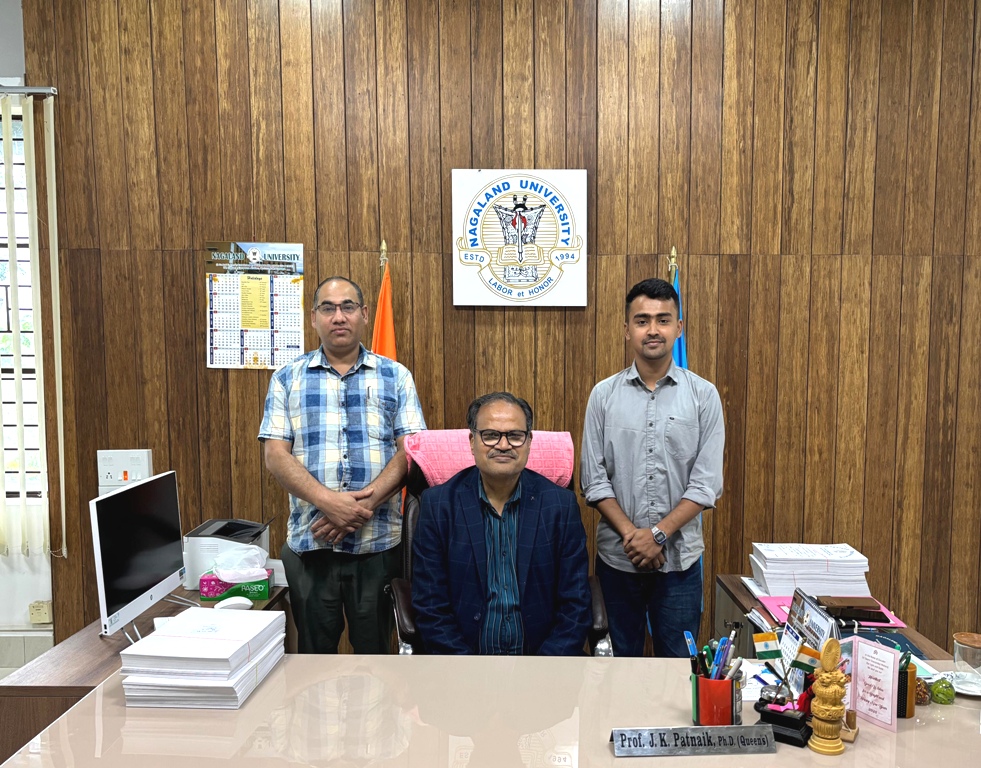
Dipankar Hazarika (right) with Prof. Jagadish K. Patnaik
(centre) and Dr. Nurul Alam Choudhury (left).
- DIMAPUR —
Nagaland University (NU) PhD scholar Dipankar Hazarika has secured the support
of the Royal Norwegian Embassy in New Delhi for his research on battery technologies,
aimed at advancing flexible, wearable, and sustainable electronic devices.
- According to a press release, his innovation could play a
critical role in supporting India’s goal for clean and safe energy storage
technologies.
- Working under the supervision of Dr. Nurul Alam Choudhury,
assistant professor in the department of Chemistry, Hazarika has been selected
for the 'Energy Innovation Fellowship Grant' to accelerate community
innovations in battery energy storage in India.
- Stating that such indigenous innovative solutions, which
directly empower local communities in battery and energy technologies, are
vital for India to achieve its commitment to net-zero emissions by 2070, the
statement read that batteries hold immense potential to transform energy access
and resilience at the community level, offering sustainable, scalable solutions
for rural development, energy equity, and livelihood enhancement.
Also read: Nagaland University-led team develops cheaper supercapacitor material
- It was mentioned that his work has already achieved
laboratory-scale validation, and an Indian patent has been filed to protect the
innovation.
- “He has already developed a lab-scale prototype, which
exhibited excellent physicochemical and electrochemical performance, including
high-rate capability, high areal capacitance, and a remarkable cycle life of
51,500 cycles at 2 mAcm⁻² in an all-solid-state supercapacitor,” it said.
- His research was recently published in the Journal of Power
Sources in a research paper titled 'An Ionically Cross-linked Chitosan Hydrogel
Membrane Electrolyte for Long-lived Electrical Double Layer Capacitors'
(https://doi.org/10.1016/j.jpowsour.2024.236037). The paper was authored by
Dipankar Hazarika, Duangailung Kamei, Nuphizo Shijoh, and Dr. Nurul Alam
Choudhury.
- Thanking the Norwegian Embassy and his university, Hazarika,
who is currently conducting his PhD research at the Laboratory for Polymer
Materials and Renewable Energy, department of Chemistry, stated that the
fellowship would significantly strengthen his research by providing access to
expert mentorship and opportunities for industry linkage.
- He expressed his belief that it would help translate his
research into a product that contributes to sustainable energy solutions.
Hazarika further noted that the next steps would involve conducting performance
testing under real-world conditions and seeking industry collaborations for
scaling up the product and bringing it to the market so the country could
benefit from the technology.
- Hazarika is one of only 13 innovators in the country to be
selected for the grant. This initiative is being implemented in collaboration
with Innovation Norway, NITI Aayog (Government of India), The Energy and
Resources Institute (TERI), and Atal Incubation Centres (AICs). The regional
host for the North East is the Atal Incubation Centre - Sikkim Manipal
University Technology Business Incubation (AIC-SMUTBI), led by Prof. Tej
Chingtham, CEO of AIC-SMUTBI.
- Congratulating the research scholar on his path-breaking
work, Prof. Jagadish K Patnaik, vice-chancellor of Nagaland University, stated
that the milestone reflects the growing research excellence at Nagaland
University and inspires others to pursue impactful science.
- The fellowship also offers mentorship and entrepreneurial
guidance from national experts. Dr. Nikhil Tambe, CEO of The Energy Consortium
at IIT Madras, is one of the key mentors guiding the fellows through technology
readiness scaling, product translation, and real-world deployment.
- Expressing gratitude to the Royal Norwegian Embassy, TERI,
and NITI Aayog for partnering with AIC-SMUTBI to support battery technology
innovations in North East India, Prof. Tej Chingtham, CEO of AIC-SMUTBI, noted
that the collaboration empowers local start-ups working on clean energy
solutions. He emphasised the anticipation for continued cooperation in driving
sustainable impact together.
- Out of over 100 proposals submitted from five regions across
India—Uttar Pradesh, Rajasthan, Punjab, Haryana, and the northeast—only 13
innovators were selected. Hazarika was one of two selected fellows from the
northeast to move forward in Phase I of the programme. His awarded project is
titled ‘Sustainable Biopolymer-based Hydrogel Electrolytes for Next-generation
Solid-state Energy Storage’.
- Highlighting the importance of such research and innovation,
Dr. Choudhury, Hazarika's PhD supervisor, remarked that Dipankar’s achievement
was a proud moment for both the laboratory and the university. He noted that
Hazarika's research shows promise in addressing real-world energy challenges
through sustainable approaches.
- Dr. Choudhury explained that biopolymers—such as chitosan
(derived from crab and shrimp shells), gelatin, starch, and cellulose—are renewable,
biodegradable, low-cost, and safe, making them ideal candidates to replace
petroleum-derived synthetic materials in green energy applications.
- He added that while electrolytes are just as critical as
electrodes in energy storage devices, research on electrolytes has received
comparatively less attention.
- This, he explained, is mainly due to the
complexity involved in designing stable, safe, and high-performing electrolyte
materials, as well as their lower visibility in performance metrics compared to
electrodes, which often receive more recognition for improving energy density.
- It was mentioned that most conventional electrolytes used
today are liquid-based. While they perform adequately, they suffer from serious
limitations such as leakage, toxicity, and high flammability. These safety and
environmental concerns have limited their suitability for use in
next-generation technologies, such as flexible or wearable electronics.
- To overcome these challenges, researchers at Nagaland
University focused on quasi-solid hydrogel electrolytes, providing a safer,
biodegradable, and more stable alternative. This approach addresses a
long-overlooked yet critical component of next-generation energy storage
systems. Hazarika’s hydrogel membrane electrolyte is based on chitosan and a
non-toxic ionic crosslinker, such as sodium carbonate.
- The hydrogel membrane electrolyte offers several benefits,
including being leak-proof and non-flammable, biodegradable and non-toxic,
cost-effective, and scalable. It also boasts excellent ionic conductivity of
7.89 mS/cm and electrochemical stability up to 2.32V.
